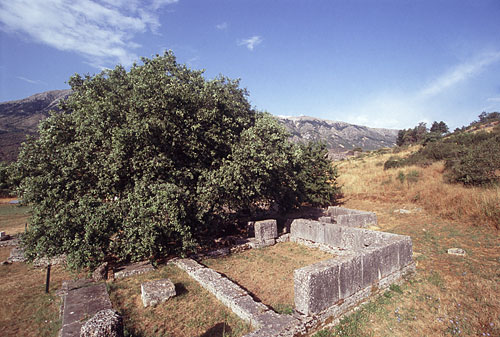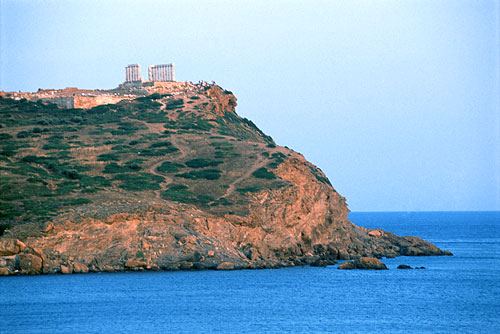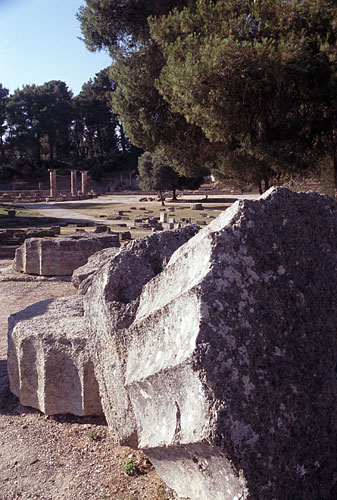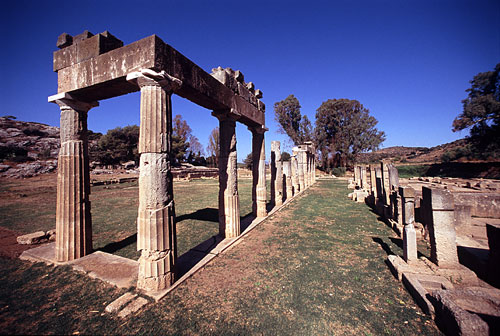inspiration, and in which the gods have their appointed lots and
are propitious to the dwellers in them.
Plato
The Neolithic Period (9600 - 3000 BC)
To explore the sacred geography of ancient Greece it is necessary to look far back in time. During the millennia before the emergence of the classical Greeks there were other peoples living in the region and traces of their wisdom traditions may still be found in the old myths. While brilliant in their achievements, the classical Greeks were not the creators of all the sophistication for which they are known. Rather, they were more the inheritors, who then went on to elaborate and express pre-existing wisdom.
The story of the region begins before any written records were kept. What little we know comes from myths and legends, folklore and the studies of archaeologists. Nomadic hunter-gatherers wandered across the lands then in ways no humans on earth do nowadays.
Their movements were guided by the passage of the seasons and the migrations of vast animal herds. The living earth gave them food and the sun warmed them. While walking here and there upon the earth, these ancient people – our own ancestors – also slowly began to find particular places that had a sense of numinosity, or power, or heightened energy. The two vantage points that we have on this fabled epoch, mythology and archaeology, show quite clearly that the earliest Greek cultures were centered on beliefs in the Great Goddess of the Earth. She gave birth to and through all things. Babies and springs were her gifts. Caves and forest groves her favored abodes. Over uncounted centuries, through the birth and passing away of prehistoric cultures, these mystic places were venerated and visited. The first sacred sites of humankind, they are the most ancient roots of the pilgrimage traditions that would later characterize classical Greece.
Around 6500 BC, six thousand years before the classical Greeks, farming and animal domestication began. Cattle may have been domesticated independently in southeastern Europe but some crops, such as wheat and barley, were certainly introduced from the Middle East. Along with ideas of agriculture and animal husbandry, so also came proto-religious concepts. During the Neolithic Period, cultures such as the Bandkeramik, Tripolye-Cucuteni, Bell Beaker, Unetice, Danubian-Carpathian, and the early Aegean traveled over, and traded within, large regions of southeastern and central Europe. Additionally, the precious stone Amber, found in the regions of present day Denmark, Poland, and Lithuania, was widely traded throughout central and southeastern Europe. All of this human movement occurred near to and within the region of Greece, and would certainly have influenced the later emergence of more sophisticated cultures in the Aegean area.
The Bronze and Dark Ages (3000 – 800 BC)
Between 3000 and 1100 BC, various groups of peoples, such as the Ionians, Achaeans, and Dorians entered Greece from the north. Of Indo-European origin, they were patriarchal, warlike cultures that believed in masculine gods which resided in the skies or upon mountain peaks. During these years, and especially following the Dorian migrations around 1100 BC, there was a gradual process of cultural blending whereby the emphasis shifted from veneration of the Earth Goddess as the dominant deity to Zeus, a sky god. This blending of the indigenous ancient goddess culture with the arriving patriarchal culture is clearly reflected in different myths deriving from Neolithic, Bronze Age and Classical periods. Many contemporary people have the notion that the Greek myths concern only Zeus and the Olympian gods. This notion, perpetuated since Victorian times when European scholars – almost entirely men – imparted a definite male bias to their interpretations and writings is, however, incorrect.
The masculine oriented myths of the Classical era are merely the products of that male-dominated time. There is a vastly older mythic tradition deriving from pre-Bronze Age times in which the Great Goddess was the supreme deity. The Great Goddess was associated with birth, ease of life, fertility, and seasonal changes, while the later Olympian gods were warlike, distant from the people, judgmental and often jealous. During the assimilation process, the Great Goddess was subdivided into different female aspects, such as Hera, Artemis, Aphrodite, Athena and Hestia. While powerful in their own right, it is significant that each of these goddesses were still subservient to male gods or masculinized themselves. For example, during their development in the Olympian order Hera became a jealous wife, Athena a masculine woman, and Aphrodite a promiscuous creature.
The establishment of shrines during the Bronze and Dark ages was very often at locations that had been venerated from earlier Neolithic times. The sanctuaries were placed at specific sites where the mysterious forces of the natural world were most accessible. To understand these early sanctuaries it is necessary to examine them in relation to the natural contexts in which they were located. Of critical importance in this examination, is recognition of the fact that the ancient sanctuaries were linked not only to specific places in the landscape but also to the movements of different celestial bodies such as the sun, moon, planets and stars.
The early sanctuaries were situated at areas of landscape associated with the spirits and powers of nature (later anthropomorphized as the goddesses and gods). Altars were set up, usually flat rocks in positions facing features of the sacred landscape, and over time more elaborate structures were added. A variety of rituals were established to honor the spirits of the landscape, to propitiate and control them, and to provide access to those powers for visiting pilgrims. It is not possible to say with any certainty at what point in time early human beings conceived of the sanctuary, yet it was well before the period of settlement. Archaeological evidence had demonstrated that dwellings were a later development at pre-existing places of sanctity. Other pre-Greek civilizations such as the Minoan, the Mycenean and the Cycladic were also associated with aspects of the Mother Goddess and related geomantic elements.
The Archaic, Classical and Hellenistic Periods
During the so-called ‘Dark Ages’ (1100 – 800 BC), the Greeks lived in tribal communities controlled by chiefs or kings who combined the roles of war leader and priest. There were no palaces and the kings lived in houses distinguished from those of their subjects only by their greater size. By the 9th century, power had begun to pass to different hereditary aristocracies, trade increased between them, and social centers began to grow in size from villages to cities. By the beginning of the Archaic Period, the Polis, or city-state became the dominant form of political organization. The cities dominated the countryside and became the primary centers of political power, commerce and cultural life. During the Archaic Period, at different times in different regions of Greece, aristocratic government became unpopular and a variety of other governing systems evolved, including tyrannies, oligarchies, and democracies. Throughout the Archaic, Classical and Hellenistic periods, the many city-states fought against one another, and therefore it is not correct to speak of a Greek ‘nation’ but rather only of a Greek civilization composed of numerous autonomous city-states.
Despite their rivalries, the Greeks had a strong sense of common identity, expressed by the name they gave themselves, Hellenes, and the religion they practiced. Worshipping the same gods and goddesses, the Greeks also celebrated pan-Hellenic festivals during which time hostilities ceased and pilgrims were safe to travel across the countryside. The neutrality of shrines and especially the oracles of pan-Hellenic importance was supported by leagues of neighboring states, called amphictionies, such as that of Delphi, the most famous oracle site. It is against this background of social, political and religious organization that we may consider the nature of sacred sites and pilgrimage traditions in the Archaic, Classical and Hellenistic periods.
In consideration of the practice of pilgrimage in these periods it is clearly evident that there were two distinct classifications of pilgrimage sites. These may be categorized as attracting individual or group pilgrimages. In the category of shrines that attracted individual pilgrims, there were the age-old oracular shrines, such as Dodona and Delphi; the shrines dedicated to specific gods and goddesses; and the healing shrines known as asklepieions. In the category of shrines that attracted group pilgrimages, there were the hugely visited, state-supported festival sites of Olympia, Delphi, Isthmia and Nemea. From the 6th century BC to the 4th century AD, the Greeks made both individual and highly organized state-sponsored pilgrimages to these holy places all across the Greek realm. The pilgrimage traditions to both types of shrines are an undeniable indication of the great degree which the Greeks viewed the gods and goddesses as intervening in their personal lives and the affairs of the state.
In the Greek world the word for sanctuary was hieron (meaning holy or sacred), which suggests the idea of a zone between the divine and human world where communications between the two realms could exist. The construction of large temples around the ancient altars from the Bronze and Dark Ages is a reflection of the monumentalization of Greek sanctuaries beginning in the 8th century. What was still primary, however, was the sacred space around the altar, sometimes including a cave, spring, tree or stone. The architectural elaboration of the temple should, therefore, not be seen as a change in cult practice but simply as a decision to monumentalize. It is also important to recognize that much of the inspiration and structural form of the Greek temples were derived from similar structures in Egypt and the Middle East. The Classical era temples, besides their spiritual functions, also served as the emblems of the city-states and the manifestation of their power within a competitive political system that spanned the entire region of Greece.
While many urban centers around Greece had their own holy places, pilgrims would often travel hundreds of miles beyond their place of habitation, by boat or land, to visit other shrines whose resident gods and goddesses were believed to be effective for different reasons. Certainly one of the most famous examples of this sort of shrine visitation was that which occurred at the oracle site of Delphi. Its earliest use lost in the mists of prehistory, Delphi was favored by the Mycenaeans from as early as 1500 BC and by the Greeks from 1000 BC to the 393 AD, when the Christian emperor Theodosius officially closed the enormous temple complex.
Another type of sacred site which attracted large numbers of pilgrims from throughout the Greek world were the healing shrines of Asklepios, the son of the legendary Apollo. His primary sanctuaries, called asklepieion were located at Epidauros, the island of Kos, Pergamos in Asia Minor, and Lebena in Crete. While approximately 300 asklepieion shrines were also constructed in other parts of the Greek world, the healing power of the god was considered to be most present at the major sanctuaries. When pilgrims came to an asklepieion shrine they would spend a night a night sleeping in a building called an avaton, where they hoped to have a dream in which Asklepios would appear and either heal them or reveal information concerning how they might heal themselves.
The second major category of pilgrimage destinations were the state-supported pan-Hellenic festivals around the country. The emergence of these particular sanctuaries was directly linked with the rise of the polis and the birth of the city-state. During the pan-Hellenic festivals thousands of people traveled to worship the gods and goddesses honored in these celebrations. The festivals of Olympia, Pythia, Isthmia and Nemea were the most important and were known as the ‘crown games’. Competitions between the city-states at the festivals included literature, music and athletics. The prizes for contestants were wreaths not money and some victors emerged as major politicians. The artistic elaboration of the shrines was also a form of competition between the states. The pan-Hellenic shrines served the function of reinforcing ideas and values central to the polis organization. This was materially expressed in the creation of monuments dedicated to the achievements of individual city-states, which were specifically designed to impress visitors from other regions. Access to the pan-Hellenic shrines was guaranteed during times of conflict between the different city-states, and even when Xerxes invaded Greece in 480 BC, the Olympic festival continued.
Official pilgrimage from the 6th century onwards was a definite feature of the Greek world and ships came from Iberia, Egypt, Cyrene and the Black Sea to the sanctuaries in Greece and Asia Minor. Diplomatic activity accompanied the festivals with different city-states sending out officials announcing the dates of celebrations and to confirm the sacred truces which allowed pilgrims to travel in safety. Invited states sent official representatives, called theoroi, to participate in the festivals and make sacrifices on the behalf of their state.
Sea travel was the primary form of transport for the Greeks and the sailing season from the beginning of spring in April to the onset of winter in October came to be the period during which the main state-supported festivals were held. The dates of the four main festivals were also set to not conflict with the busiest periods of the agricultural schedule, such as the grape harvest in mid-September, the grain harvest in May to July, and the olive harvest between November and February.
Still another category of pilgrimage destination in the Classical Greek world was that of Mystery Religions. Much about the mystery religions and their rituals is currently unknown but they seemed to have functioned as sources of spiritual vitality amidst the institutional bureaucracy of the state religion. The festival of the Greater Mysteries (as contrasted to the Lesser Mysteries) occurred at the site of Eleusis during the month of September and October. The mysteries were essentially a drama in which the public participated, enacting a ritual progression from sadness to joy, from the sorrow of the separated mother and daughter to their joyful reunion. During the week-long festival various rituals were performed by priests and priestesses at the shrine of Eleusis, and on the fifth day of the festival many thousands of pilgrims, men and women, rich and poor, walked a distance of approximately 15 miles from the city of Athens. Aspects of the Eleusinian mysteries were partially a re-enactment of the myth of Demeter and Persephone, and participants drank a sacred beverage called the kykeon, which some scholars theorize may have had a narcotic effect. Occurring for nearly 1000 years, the procession to Eleusis was the greatest such event ever organized in the Greek world. The Eleusinian mysteries came to an end in 396 AD with the destruction of the sanctuary by Alaric the Goth.
Another mystery tradition, the Kaveirian, was practiced on the islands of Samothrace and Lemnos in the northern Aegean during the Classic and Hellenistic periods. The Kaveirian Mysteries were most probably imported from Asia Minor and their contents were then mixed with Greek mythology and legends.
The Locations of Greek Sanctuaries according to Sacred Geography
In preceding sections of this essay information has been presented regarding the origin of sacred sites in the Neolithic period and their religious use from the Bronze Age to the end of Hellenistic times. This information has been drawn from a variety of orthodox scholarly sources which, while certainly important, fail to address the issue of the location of the most ancient sacred sites in terms of geomancy, terrestrial astrology and landscape geometry. An intriguing fact, little known to most contemporary scholars of Greek archaeology, is that there is actually a geometrical pattern to the placement of sacred sites throughout the mainland and islands of Greece.
Evidence of this grand design was first discovered, at least in historical times, by the French scholar Jean Richer who was living in Greece in the 1950’s. Having had for many years an interest in the study of mythology, esoteric doctrines and Greek mythology, Richer often wondered if there might be a unifying pattern explaining the locations of the most ancient Greek temples relative to one anther, to the typography of the entire country, and to the celestial realm. During his visits to numerous temples, on both the mainland and the islands, he had been perplexed by their sometimes unusual locations. He had found temples perched high on mountain peaks, in isolated regions far distant from social centers, and, most mysteriously, at seemingly random places in the countryside. Richer suspected that the locations of these temple sites were not arbitrary but were rather a reflection of a wisdom tradition practiced in deep antiquity and then forgotten millennia ago.
In 1958 Richer had a profound experience which began to unlock the mysteries that so intrigued him. While living on the hill of Lycabettos, sacred to the Earth Goddess Gaia and overlooking the Parthenon of Athens, he had a visionary dream of Apollo. The dream helped him to recognize that a straight line could be drawn between the sites of Delphi, Athens, the island of Delos (where Apollo was supposedly born) and Camiros in Rhodes, the site of the oldest Apollo temple on that island. The discovery of this line, linking holy places of ancient Greece, led Richer to discover more examples of ancient sacred geography including:
- An alignment linking the sacred mountains of Ida on Crete and Parnassus at Delphi, which also passed through another sacred mountain at Corinth, where stood a temple of Apollo.
- A general alignment of three great Hera sanctuaries at Olympia, Argos and Samos.
- An almost equilateral triangle that linked three sanctuaries of Athena at Delphi, Athens and Tegea.
- An alignment of the cities of Corinth, Argos and Sparta at a right angle to the Delphi - Athens - Delos alignment.
Richer felt that these enigmatic alignments of sacred sites were clearly apparent if an observer could free themselves of the limiting bias of orthodox archaeology. Instead of studying each temple as a discreet unit, the observer needed to consider, as if from a bird’s eye view, the network of sanctuaries across the entire region of Greece. In his book, Sacred Geography of the Ancient Greeks, Richer wrote,
“The evidence of the monuments shows in an undeniable way, but not yet clearly perceived, that during more than two thousand years, the Phoenicians, the Hittites, the ancient Greeks, and then the Etruscans, the Carthaginians, and the Romans, had patiently woven a fabric of correspondences between the sky, especially the apparent course of the sun through the zodiac, the inhabited earth, and the cities built by humanity.”
Other scholars have studied Richer’s theories and the alignments he found. Writing in Dance of the Dragon: an Odyssey into Earth Energies and Ancient Religion, Paul Broadhurst has said,
“In the following years, Richer found more of these lines and eventually uncovered the whole plan behind the Delphic zodiac. Studying the iconography of coins and temple sculpture, he found that the designs were not merely decorative, but astrological, reflecting the cosmic influences at work in each particular segment. He even found he could use this specific knowledge to predict successfully which symbol would appear on coins from specific locations. As his researches progressed, he discovered that statues of mythical beasts and Gods and Goddesses, as well as temple dedications, were originally designed to reflect the divisions of the zodiac. Temples at great distances from one another were aligned with their faraway counterparts, reflecting the heavenly divisions on the surface of the land, all part of a vast system of Cosmic and Earthly correspondences. Temple sculpture also reflected the cyclic wheel of the zodiac. The fighting animals common on temple pediments symbolized certain seasons or astrological periods, devouring or attacking the dying cosmic influences, with each period represented by a mythical beast…..Later, Richer found other zodiacs centered on similar oracular sites having geometrical relationships with one another, and concluded that he was finding the remnants of a once universal system of heavenly correspondences which had evolved through Greek and Roman times as the common denominator of ancient religions, even extending into Byzantine Christianity.”
In 1994, Richer’s book, Sacred Geography of the Ancient Greeks, was translated from French into English by Christine Rhone. Based on a deep familiarity with his work, Rhone commented in her preface to the book,
“Richer’s work on sacred geography can be approached from many levels. He extends the range of astrological symbols from the familiar ones – the fish for Pisces, the bull for Aries, and so on – to encompass Olympian and pre-Olympian deities, circumzodiacal constellations, figures of myth and legend, revealing the stratum of stellar beliefs that underlay ancient Greek religion. This expanded range of astrological symbols becomes a key to interpreting the motifs of architecture, sculpture, vase painting and other artifacts. These motifs were not chosen merely for aesthetic reasons, as compositional devices or pictorial narrative, but were chosen to express a specific temporal and spatial meaning of the artwork in relation to a sacred center. This was most often an oracle site, a timeless place between the realms of Earth and the god-like stars. Every object of sacred art, great or small, was thus a point in single web of meaning that imbued it with a talismanic power.”
Following Jean Richer’s passing away in 1992, his elder brother Lucien extended the ‘Apollo’ line passing through Delos, Delphi and Athens, to discover that it linked other ancient shrines including Skellig Michael in Ireland, St. Michael’s Mount in Cornwall, England, Mont St Michel in France, Sacra di San Michele in Italy, San Michele di Monte Gargano on the eastern coast of Italy, and Mt. Carmel in the Holy Land. Discussing this incredibly ancient and significant sacred geography, Lucien wrote,
“Jean has shown the way ahead by proving that the great sanctuaries of ancient times were generally positioned in relation to each other according to zodiacal directions…..On a global scale, it emerges that the placing of sacred sites seems to obey precise rules and that, despite appearances, the various aspects of the terrestrial surface represent highly organized structures.”
In this present essay it has been shown that while the Classical era Greeks did indeed erect stupendous temples at many sites throughout the mainland and the islands, the sites where those temples were placed had already been sacred sites of little known, but deeply knowledgeable, cultures which existed thousands of years before Greek times. Therefore it can be said with assurance, as was stated at the beginning of this essay, that the Classical Greeks were not so much creators of their sacred geography but rather inheritors of that system from an earlier people.
Those ancient sages who sought to obtain the presence of divine beingsby setting up shrines and statues seem to me to have shown insight into
the nature of the universe. They understood that it is always easy to attract
soul and particularly simple to keep it by constructing an object fashioned
so as to be influenced by it and to receive a share of it.
Plotinus, The Soul, 10

Oracle of Zeus, Dodona

Cape Sounion

Temples of Hera and Zeus, Olympia

Temple of Artemis, Vrauronia
 Martin Gray is a cultural anthropologist, writer and photographer specializing in the study of pilgrimage traditions and sacred sites around the world. During a 40 year period he has visited more than 2000 pilgrimage places in 165 countries. The World Pilgrimage Guide at sacredsites.com is the most comprehensive source of information on this subject.
Martin Gray is a cultural anthropologist, writer and photographer specializing in the study of pilgrimage traditions and sacred sites around the world. During a 40 year period he has visited more than 2000 pilgrimage places in 165 countries. The World Pilgrimage Guide at sacredsites.com is the most comprehensive source of information on this subject.For additional information:
Sacred Geography in Greece at ancient-wisdom.
Seismic faults and sacred sanctuaries in Aegean antiquity.